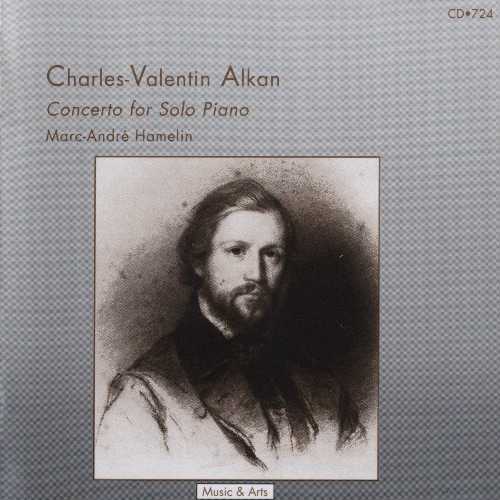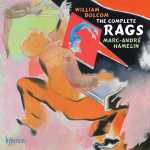
Performer: Marc Andre Hamelin
Composer: Leo Ornstein
Audio CD
SPARS Code: DDD
Number of Discs: 1
Format: FLAC (tracks)
Label: Hyperion
Size: 242 MB
Recovery: +3%
Scan: yes
# Suicide in an Airplane, for piano
Composed by Leo Ornstein
with Marc-Andre Hamelin
# A la Chinoise, for piano, Op. 39
Composed by Leo Ornstein
with Marc-Andre Hamelin
# Wild Men’s Dance (Danse sauvage) for piano, , Op. 13/2
Composed by Leo Ornstein
with Marc-Andre Hamelin
# Poems of 1917, for piano, Op. 41
Composed by Leo Ornstein
with Marc-Andre Hamelin
# Arabesques, for piano, Op. 42
Composed by Leo Ornstein
with Marc-Andre Hamelin
# Impressions de la Tamise, for piano, Op. 13/1
Composed by Leo Ornstein
with Marc-Andre Hamelin
# Piano Sonata No. 8
Composed by Leo Ornstein
with Marc-Andre Hamelin
01. Suicide In An Airplane
02. A La Chinoise, Op.39
03. Danse Sauvage, Op.13 No.2
04. No.1. No Man’s Land – Andante Espressivo
05. No.2. The Sower Of Despair – Moderato
06. No.3. The Orient In Flanders – Andantino (Molto Espressivo)
07. No.4. The Wrath Of The Despoiled – Sostenuto (Molto Appassionato)
08. No.5. Night Brooding Over The Battlefield – Moderato E Misterioso
09. No.6. A Dirge Of The Trenches – Lento
10. No.7. Song Behind The Lines – Andante Con Moto E Malinconioso
11. No.8. The Battle – Allegro E Molto Appassionato
12. No.9. Army At Prayer – Allegro, Ma Non Troppo
13. No.10. Dance Of The Dead – Vivo (Con Fuoco)
14. No.1. The Isle Of Elephantine
15. No.2. Primal Echo
16. No.3. Chant Of Hindoo Priests
17. No.4. Shadowed Waters
18. No.5. A Melancholy Landscape
19. No.6. Pompeian Fresco
20. No.7. Passion
21. No.8. Les Basoches
22. No.9. The Wailing And Raging Wind
23. Impressions De La Tamise, Op.13 No.1
24. I. Life’s Turmoil And A Few Bits Of Satire
25. II. A Trip To The Attic – A Tear Or Two For A Childhood Forever Gone: The Bugler
26. II. A Trip To The Attic – A Tear Or Two For A Childhood Forever Gone: A Lament For A Lost Boy
27. II. A Trip To The Attic – A Tear Or Two For A Childhood Forever Gone: A Half-Mutilated Cradle – Berceuse
28. II. A Trip To The Attic – A Tear Or Two For A Childhood Forever Gone: First Carousel Ride And Sources Of A Hurdy-Gurdy
Astounding
Leo Ornstein (1892/93-2002) is presumably the longest-living composer of all time, and that fact alone may have helped give his music some curiosity value – at least a couple of discs arrived in the aftermath of his death. But as the music on this disc shows his music doesn’t only have curiosity value. Of course, Marc Andre Hamelin’s magical playing helps a lot, and one suspects that Hamelin might be able to convince listeners that something has musical worth when it really doesn’t, but I am pretty sure these fascinating pieces can stand on their own and have a successful life in the concert hall in the hands of other pianists as well.
Ornstein started out as something of an enfant terrible with a series of freely atonal works in the second decade of the twentieth century before mellowing into a more conservative style later on. The music on this disc reveals a composer who has something in common with the American ultra-modernists, but who had, to be honest, a wider compositional range and imagination than some of those ultra-modernists. The earlier works – all except the eighth sonata on this disc – are full of craggy harmonies, clusters and propulsive rhythms, but with glimpses of melodies and a deeply satisfying narrative momentum . Like the aforementioned ultra-modernists, Ornstein employs the avant-gardistic effects in very non-abstract, almost onomatopoetic ways; Suicide in an Airplane, for instance, is a vivid, motoric, depiction of a doomed plane ride, subtle as, well, a plane crash but extremely effective – captivating, even. The sheer variety and range of imagination deployed in these works is striking, however, and none of the pieces are anything less than fascinating.
The Eighth Sonata dates from the composer’s nineties, and the compositional language has become far more “refined” – it lacks the energy of the earlier works, but the composer’s imagination was hardly less fertile at this point. The sonata is eclectic and full of color, combining something of Ives’s deployment of popular themes with Gallic wit and fluency, and despite the somewhat more “classical” idiom the work is immediately recognizable as being penned by the same hand that penned the earlier works.
Hamelin’s playing range from the magical to the breath-taking. Not only is he, as expected, unfazed by the technical challenges; he plays it all with a flair and a range of moods and colors that is absolutely astonishing – listen in particular to his ways of characterizing the various shorter movements that make up the sonata. The sound is good and the notes are up to Hyperion’s usual standards. A major achievement, and a real must for anyone with an even passing interest in twentieth century music.




Thanks Whatever :-)
More Hamelin!